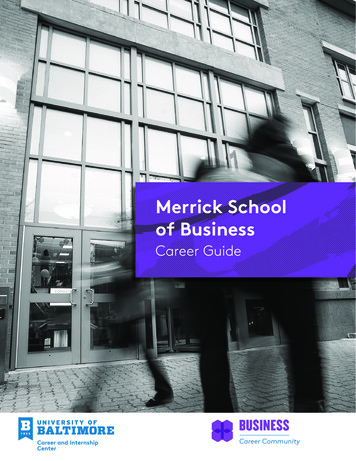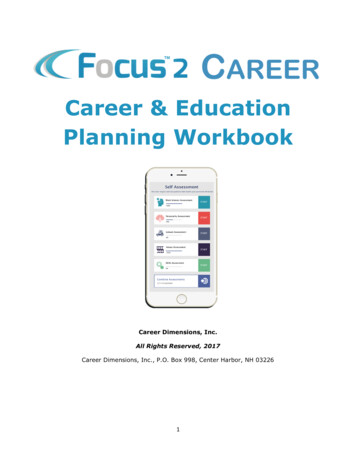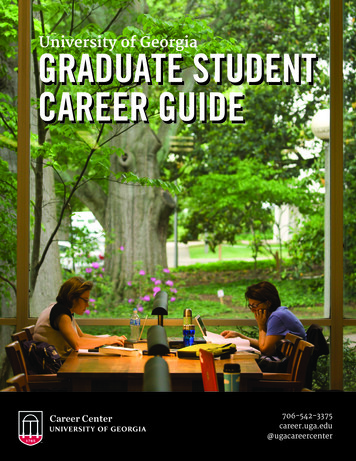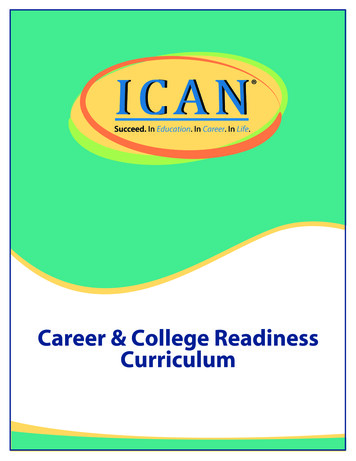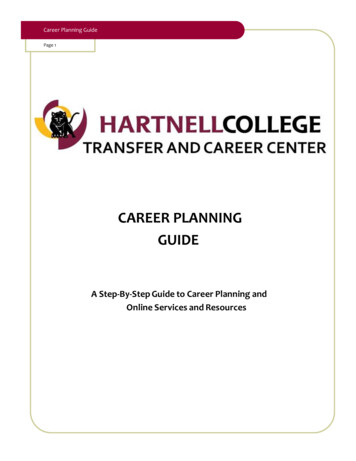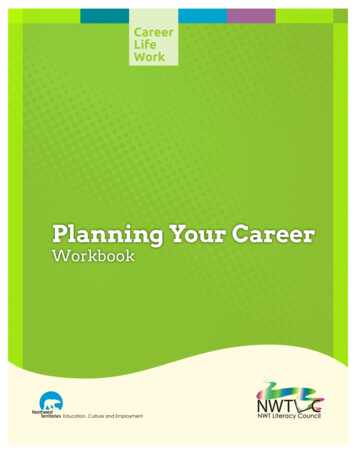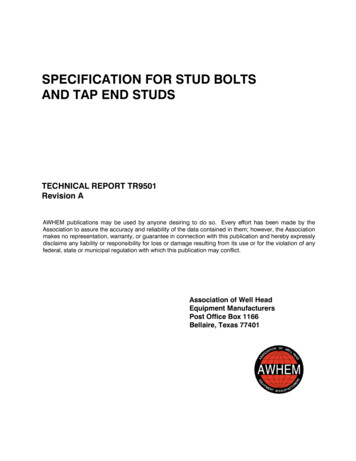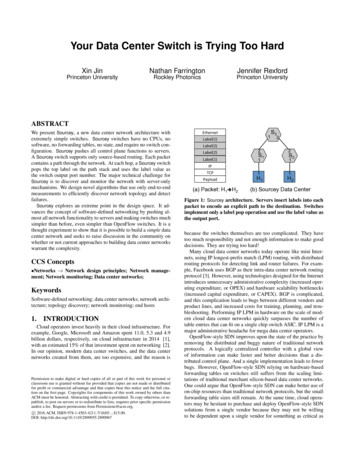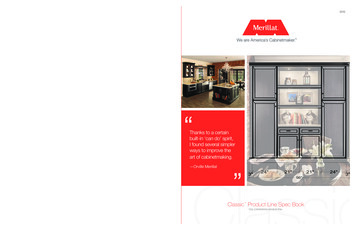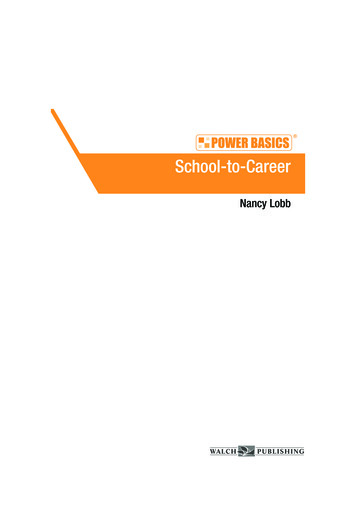
Transcription
PB SPEC School to Career TB9/14/0510:52 AMPage i School-to-CareerNancy Lobb
PB SPEC School to Career TB9/14/0510:52 AMPage iii Table of ContentsTo the Student . . . . . . . . . . . . . . . . . . . . . . . . . . . . . . . . . . . . . . . . . . . . . . . . . vUnit 1: Looking to the FutureLesson 1: Understanding Yourself . . . . . . . . . . . . . . . . . . . . . . . . . . . . . . 3Lesson 2: Identifying Your Abilities . . . . . . . . . . . . . . . . . . . . . . . . . . . . . 8Lesson 3: Identifying Your Interests . . . . . . . . . . . . . . . . . . . . . . . . . . . 18Lesson 4: Understanding Your Personality . . . . . . . . . . . . . . . . . . . . . . 24Lesson 5: Understanding Your Values . . . . . . . . . . . . . . . . . . . . . . . . . . 28Lesson 6: Exploring Career Goals . . . . . . . . . . . . . . . . . . . . . . . . . . . . . 35Unit 2: Getting a JobLesson 7: Using Resources to Find Job Openings . . . . . . . . . . . . . . . . . 51Lesson 8: Applying for a Job . . . . . . . . . . . . . . . . . . . . . . . . . . . . . . . . . 65Lesson 9: Interviewing for a Job . . . . . . . . . . . . . . . . . . . . . . . . . . . . . . . 75Unit 3: Doing Your Best WorkLesson 10: Starting a New Job . . . . . . . . . . . . . . . . . . . . . . . . . . . . . . . . 89Lesson 11: Looking Right for the Job . . . . . . . . . . . . . . . . . . . . . . . . . . . 93Lesson 12: Learning Your Job . . . . . . . . . . . . . . . . . . . . . . . . . . . . . . . . . 97Lesson 13: Using Good Work Habits . . . . . . . . . . . . . . . . . . . . . . . . . . 101Unit 4: Communicating at WorkLesson 14: Speaking Effectively at Work . . . . . . . . . . . . . . . . . . . . . . . 121Lesson 15: Listening for Success at Work . . . . . . . . . . . . . . . . . . . . . . 131Lesson 16: Communicating with Body Language . . . . . . . . . . . . . . . . 136Lesson 17: Using the Telephone . . . . . . . . . . . . . . . . . . . . . . . . . . . . . . 143Lesson 18: Dealing with Customers . . . . . . . . . . . . . . . . . . . . . . . . . . 150iiiSchool-to-Career
PB SPEC School to Career TB9/14/0510:52 AMPage iv Table of Contents, continuedUnit 5: Getting Along with Your Boss and CoworkersLesson 19: Getting Along with Your Boss . . . . . . . . . . . . . . . . . . . . . . 163Lesson 20: Getting Along with Your Coworkers . . . . . . . . . . . . . . . . . 169Unit 6: Meeting Challenges at WorkLesson 21: Being a Safe Worker . . . . . . . . . . . . . . . . . . . . . . . . . . . . . 187Lesson 22: Handling Problems on the Job . . . . . . . . . . . . . . . . . . . . . 199Unit 7: Getting Ahead at WorkLesson 23: Getting Raises and Promotions . . . . . . . . . . . . . . . . . . . . 223Lesson 24: Moving Ahead to Reach Your Career Goal . . . . . . . . . . . . 231Appendix . . . . . . . . . . . . . . . . . . . . . . . . . . . . . . . . . . . . . . . . . . . . . . . . 242Glossary . . . . . . . . . . . . . . . . . . . . . . . . . . . . . . . . . . . . . . . . . . . . . . . . . 258Index . . . . . . . . . . . . . . . . . . . . . . . . . . . . . . . . . . . . . . . . . . . . . . . . . . . 271ivSchool-to-Career
PB SPEC School to Career TB9/14/0510:53 AMPage 87UNIT 3Doing Your Best Work
PB SPEC School to Career TB9/14/0510:53 AMPage 89LESSON 10: Starting a New JobGOAL: To know how to start a new job rightWORDS TO KNOWadvancementcoworkersentry-level jobappropriateemployee handbookunwritten rulescooperateStarting Off RightThe first day on a new job is always a challenge. It won’t take long beforeyou feel comfortable, but it is important to start off right. Knowing what todo can help you get along better with your boss and your coworkers (thepeople you work with).A good way to start off right is to get to work on time. Of course, that’simportant every day, but on the first day it’s doubly important.Before your first day on the job, see how long it will take you to get towork. If you will be driving to work, take a test drive at the same time ofday as you will report for work. If you will take the bus or subway, take aride to your new workplace to see how long it takes.IN REAL LIFEKim’s career goal was to become a paralegal. Part of hercareer plan was to get a part-time job working in a lawfirm. She found a job as an office assistant in a law firmnear her home. The pay was good for an entry-level job(a beginning job). When she finished her communitycollege program, there was a chance for advancement,or promotion, to a full-time paralegal position. Kim wasthrilled when she found out she’d been hired. She decidedto start off right and work hard at her new job so shewould meet her career goals.89Lesson 10: Starting a New Job School-to-Career
PB SPEC School to Career TB9/14/0510:53 AMPage 90Allow yourself plenty of time to get ready the morning of your first day.Plan to arrive at your job about five to ten minutes before you areexpected.You will have a lot of new people to meet on your first day. One of themost important of these people is your new boss. Smile and shake handswhen you are introduced. It is a good idea to ask your boss what he or shewould like to be called. You can say, “Should I call you Mrs. Barnes?” It isnot a good idea to call your boss by his or her first name unless you havebeen told to do so.You may have to introduce yourself to your new coworkers. When youdo this, be pleasant and smile. Try hard to learn their names as soon as youcan. Be friendly to all your coworkers. But don’t try to be “best friends” toofast. It’s better to get to know everyone a little better before you makefriends. (We will talk about this more in Lesson 20.)Your coworkers will probably offer to show you the ropes. Be sure totake advantage of this. Cooperate—work as part of the team. Askquestions about things you don’t understand, and listen carefully to whatyou are told. You may want to take notes. No one expects you to knowwhat to do the first day. But employers do expect you to show a desire tolearn.No matter what jobs you are given, do your best. Show that you want todo the job right. Since you are new, you are likely to be given some simpletasks at first. Don’t complain. Do these jobs to the best of your ability. Ifyou do well, you’ll be given other things to do later on.TIPIt is hard work starting a new job. Be sure to take care ofyourself so you’ll feel your best. Get plenty of rest and eatgood meals. Things are sure to go better if you do.You will probably be given an employee handbook on your first day ofwork. This is a set of written rules for what is expected of all employees.(We’ll talk about this more in Lesson 12.)There are also unwritten rules in your workplace. These are the rulesthat “everybody knows,” but that no one has thought about writing in the90Unit 3: Doing Your Best Work School-to-Career
PB SPEC School to Career TB9/14/0510:53 AMPage 91handbook. You will learn these rules by watching your coworkers andpaying attention to what is going on around you. You will soon learn whattype of clothing is appropriate, or suitable, by observing what the otherworkers are wearing. The men may be wearing suits and ties or just khakipants and polo shirts. The women may be wearing nice dresses or just ablouse and pants. Maybe most of them are wearing uniforms.You can also learn a lot about the tone of the workplace by observation.It may be very quiet, very noisy, or somewhere in between. Whatever thetone is, you will need to fit in.By looking around you, you can see if all the workstations are perfectlyorderly or if a few piles of paper on the desk are all right. You may even seethat most of the desks are pretty messy.Another thing you can pick up by observation is the generalatmosphere of the workplace. In the lunchroom or break room the workersmay keep to themselves. It may be very quiet and serious. There may be afriendly chatter or there may be a lot of joking around.You may not find written rules about these things. But if you areobservant your first days on the job, you will see how best to fit in with theother workers.TIPGive your new job (and yourself ) a fair chance. Don’t takethe easy way out and quit if the going gets rough. There isalways an adjustment period in any new job. PRACTICE 17: Starting Out RightAnswer the following on a separate sheet of paper.1. Why do you think you should not call your boss by his or her firstname unless you are told to do so?2. Why do you think it’s a good idea to learn your coworkers’ names asquickly as possible?3. Why is it so important to be on time the first day?91Lesson 10: Starting a New Job School-to-Career
PB SPEC School to Career TB9/14/0510:53 AMPage 924. Circle the letter of each statement that is an example of how youshould act on your first day of work:a. If coworkers offer to show you how to do a task, tell them “no!”After all, you don’t want to look dumb.b. If you aren’t sure if you can leave on your lunch hour, leave bythe back door. Maybe no one will notice.c. Call your boss and coworkers by their first names.d. Don’t worry about learning anyone’s name. It’s not important.e. Ask questions about any instructions that are not clear to you.f . If you don’t understand how to do something, don’t worryabout it. Just go ahead and do what you want.g. Eat snacks and soft drinks at your desk if you feel like it; that isyour right.h . Invite your boss and coworkers to your place after work tocelebrate your first day on the job.i . Take a break whenever you get tired. There is no limit on restbreaks.j . If your boss has a messy desk, don’t worry about picking upafter yourself or keeping your things neat.k . Don’t complain about the jobs you are given even if some ofthem seem boring.l . Show that you are willing to learn how to do new things.92Unit 3: Doing Your Best Work School-to-Career
PB SPEC School to Career TB9/14/0510:53 AMPage 93LESSON 11: Looking Right for the JobGOAL: To know how to look right for a jobWORDS TO KNOWclothing dress codescentDressing for a JobBeing well-groomed (neat and clean) and dressing appropriately for thejob are two easy but important ways to keep your job. Many employers(bosses) feel that the appearance of their employees (workers) is areflection on the company. Workers who are neat and attractive make thecompany look good. Workers who are sloppy give the impression that theywill do sloppy work as well.Looking and Smelling CleanThe most important part of good grooming is being clean. There is nosubstitute for that daily bath or shower followed by clean underwear andsocks. Keep your hair washed and trimmed neatly. Your hands should beclean, and your nails trimmed to a reasonable length. Brushing your teethregularly will give you clean teeth and fresh breath.Smelling good is important. Using a deodorant after your shower willcontrol body odor. A deodorant is a product that is used to eliminateodors. If you have a special scent (a perfume or an aftershave lotion) youlike to wear, use only a little or none to avoid bothering your coworkers.Dressing for the JobIt is important to most employers that their employees dress right forwork. Dressing right for work shows that you think your job is important.93Lesson 11: Looking Right for the Job School-to-Career
PB SPEC School to Career TB9/14/0510:53 AMPage 94IN REAL LIFEJuan and Joel were enrolled in business courses in acommunity college. Their career goal was to becomedepartment managers in a large building supply store intown. As part of their career plans, the two got part-timejobs as clerks at the building supply store. The storemanager gave each boy two T-shirts with a store logo onthe front. The boys were instructed to wear the shirts everyday to work with clean jeans.Juan washed his shirts after he had worn them to workonce. He discovered that they didn’t need ironing if heshook them out and hung them up after drying them.Joel tossed his shirts on the floor after wearing them. Hedidn’t worry about washing them. He didn’t think thecustomers would notice if they were a bit dirty. He alwayswore plenty of body spray to cover up any unpleasantscent.The building supply store let Joel go after a few customerscomplained. Joel couldn’t believe his appearance had reallycost him his job. Now he would have to rethink his careerplan as well.Some workers are asked to wear uniforms to work. A uniform is aspecial kind of clothing that identifies workers as part of a group. If youwear a uniform, you don’t have to choose what to wear every morning, butyou do need to keep your uniforms clean and pressed.Most people don’t wear uniforms to work. They have to choose what towear to work every day. Different types of clothing are right for differentjobs. Your company may have a dress code. A dress code is a list of writtenrules that state what clothing is to be worn for work.If your company does not have a dress code, it is up to you to find outwhat is appropriate. Dress as your coworkers do, neither more casually nor94Unit 3: Doing Your Best Work School-to-Career
PB SPEC School to Career TB9/14/0510:53 AMPage 95more dressy. Avoid wearing clothing fads to work. A fad is trendy clothingthat will be in style only a short time. Avoid clothing with symbols orsayings on it. Instead, buy classic clothing of good fabric that will washwell and last a long time.Choose clothing that fits well and is neither too tight nor too loose.Your clothing should be comfortable for you to work in.Some clothing requires ironing before it can be worn to work. However,many items of clothing are wash and wear. Clothes that are made with apolyester and cotton blend often do not need ironing if you remove thempromptly from the dryer. If left in the dryer, the clothes will be wrinkled.Ask a clerk in the clothing store to help you choose items that will be easyto wash and need no ironing.Wear shoes that are comfortable all day long. If your job keeps you onyour feet all day, make sure your shoes will feel good all day, too. Keep yourshoes clean and polished.If you wear jewelry, make sure it is simple. Don’t wear a lot of chains,earrings, or bracelets.TIPLook at yourself in the mirror before you leave for work tomake sure you look right for your job. Then answer thefollowing questions about your appearance: Is your hair neat and trimmed? Is your body clean? Isyour face shaved or facial hair trimmed? Is yourmakeup applied in good taste? Is your clothing appropriate? Is it clean, unwrinkled,and appealing? Are your shoes clean and polished? Are theycomfortable to wear all day? Is your jewelry simple and not overdone? Overall, are you well-groomed?95Lesson 11: Looking Right for the Job School-to-Career
PB SPEC School to Career TB9/14/0510:53 AMPage 96 PRACTICE 18: Grooming and Dressing for SuccessAnswer the following questions on a separate sheet of paper.1. Why do you think a drugstore would lose customers if its pharmacytechnicians were poorly groomed?2. Why do you think a clothing salesperson will make fewer sales if heor she is poorly groomed?3. Why do you think a receptionist who dresses in clothes that do notfit well or are wrinkled does not make the company look good?4. Why do you think wearing strong perfume or aftershave is not agood idea at work?5. Why do you think it would matter to a boss whether his or heremployees are neat and clean?6. How do you think having neat and clean workers could affect theoverall sales of a company?7. How do you react if a grocery store cashier who is helping you hasdirty hands or clothing?8. How do you think you can be sure to wear the right clothes to work?9. Why do you think it is important to dress correctly for work?10. Why do you think it might be a good idea to lay out your clothing forwork the night before?11. Why do you think your boss has the right to tell you what you can orcannot wear?12. How could you know if an item of clothing you are thinking aboutbuying for work would be easy to wash and need no ironing?96Unit 3: Doing Your Best Work School-to-Career
School-to-CareerTeacher’s GuideWALCHPUBLISHING
Table of ContentsTo the Teacher . . . . . . . . . . . . . . . . . . . . . . . . . . . . . . . . . . . . . . . . . . . . . . . . . . . . . . . . . . ivClassroom Management . . . . . . . . . . . . . . . . . . . . . . . . . . . . . . . . . . . . . . . . . . . . . . . . . . viApplication Activity Rubric . . . . . . . . . . . . . . . . . . . . . . . . . . . . . . . . . . . . . . . . . . . . . . . viiUse Chart . . . . . . . . . . . . . . . . . . . . . . . . . . . . . . . . . . . . . . . . . . . . . . . . . . . . . . . . . . . . . viiiUnit 1: Looking to the FutureUnit Overview . . . . . . . . . . . . . . . . . . . . . . . . . . . . . . . . . . . . . . . . . . . . . . . . . . . . . . . . . . . 1Suggested Activities . . . . . . . . . . . . . . . . . . . . . . . . . . . . . . . . . . . . . . . . . . . . . . . . . . . . . . 4Unit 2: Getting a JobUnit Overview . . . . . . . . . . . . . . . . . . . . . . . . . . . . . . . . . . . . . . . . . . . . . . . . . . . . . . . . . . . 5Suggested Activities . . . . . . . . . . . . . . . . . . . . . . . . . . . . . . . . . . . . . . . . . . . . . . . . . . . . . . 7Unit 3: Doing Your Best WorkUnit Overview . . . . . . . . . . . . . . . . . . . . . . . . . . . . . . . . . . . . . . . . . . . . . . . . . . . . . . . . . . . 8Suggested Activities . . . . . . . . . . . . . . . . . . . . . . . . . . . . . . . . . . . . . . . . . . . . . . . . . . . . . . 10Unit 4: Communicating at WorkUnit Overview . . . . . . . . . . . . . . . . . . . . . . . . . . . . . . . . . . . . . . . . . . . . . . . . . . . . . . . . . . 11Suggested Activities . . . . . . . . . . . . . . . . . . . . . . . . . . . . . . . . . . . . . . . . . . . . . . . . . . . . . 13Unit 5: Getting Along with Your Boss and CoworkersUnit Overview . . . . . . . . . . . . . . . . . . . . . . . . . . . . . . . . . . . . . . . . . . . . . . . . . . . . . . . . . . 15Suggested Activities . . . . . . . . . . . . . . . . . . . . . . . . . . . . . . . . . . . . . . . . . . . . . . . . . . . . . 16Unit 6: Meeting Challenges at WorkUnit Overview . . . . . . . . . . . . . . . . . . . . . . . . . . . . . . . . . . . . . . . . . . . . . . . . . . . . . . . . . . 17Suggested Activities . . . . . . . . . . . . . . . . . . . . . . . . . . . . . . . . . . . . . . . . . . . . . . . . . . . . . 19Unit 7: Getting Ahead at WorkUnit Overview . . . . . . . . . . . . . . . . . . . . . . . . . . . . . . . . . . . . . . . . . . . . . . . . . . . . . . . . . . 20Suggested Activities . . . . . . . . . . . . . . . . . . . . . . . . . . . . . . . . . . . . . . . . . . . . . . . . . . . . . 21Answer Key . . . . . . . . . . . . . . . . . . . . . . . . . . . . . . . . . . . . . . . . . . . . . . . . . . . . . . . . . . . . 22Graphic Organizers . . . . . . . . . . . . . . . . . . . . . . . . . . . . . . . . . . . . . . . . . . . . . . . . . . . . . . 34Student Book Appendix . . . . . . . . . . . . . . . . . . . . . . . . . . . . . . . . . . . . . . . . . . . . . . . . . . 39Student Book Glossary . . . . . . . . . . . . . . . . . . . . . . . . . . . . . . . . . . . . . . . . . . . . . . . . . . . 51iii 2006 Walch PublishingTeacher’s Guide School-to-Career
Unit 3: Doing Your Best WorkThis unit discusses how to do your best work once you have been hired for a job. In Lesson 10,students learn ways to start a new job on the right foot. Lesson 11 addresses the importance of goodgrooming and appropriate dress on the job. In Lesson 12, students learn how to obtain informationthey need on the job, including using the employee handbook and learning new skills. In Lesson 13,students review the attitudes and work habits that will help them keep their jobs.Lesson 10—Starting a New JobGoal: To know how to start a new job rightWORDS TO KNOWadvancementa promotion to a better jobappropriatesuitable for a particular place or occasioncooperateto work with others to achieve a common goalcoworkersthe people with whom you workemployee handbook a book that states company rules and benefitsentry-level joba job for a person with little or no experienceunwritten rulesrules that have not been formally written down but that are commonly held toLesson 11—Looking Right for the JobGoal: To know how to look right for a jobWORDS TO KNOWclothing fadstrendy clothing that will only be in style a short timedeodoranta product used to cover up body odorsdress codewritten rules that state what clothing is to be worn to workemployeesworkersemployersbossesscenta perfume or other pleasant smell8Teacher’s Guide School-to-Career 2006 Walch Publishing
uniforma type of clothing that identifies a group of workerswell-groomedappearing neat and cleanLesson 12—Learning Your JobGoal: To know how to learn more about your jobWORDS TO KNOWfireddismissed from a job for causeon-the-job trainingbeing trained for your job while you workreprimanda formal complaint against a workerscanto look something over quickly but systematicallyLesson 13—Using Good Work HabitsGoal: To know the work habits valued by employersWORDS TO KNOWattitudea state of mind or point of viewcommunicateto exchange ideas or informationcorrectionthe pointing out of a mistakedeadlinea set time by which something must be donegoalthe purpose toward which one is workinggossiptalking about others and their personal businessinterruptionsbreaking in or stopping of somethingorderlyneat, well-arrangedresponsiblereliable; dependableschedulea list or timetable9 2006 Walch PublishingTeacher’s Guide School-to-Career
Sequencing ChartWrite the first step or event in the first box. Write the other steps or events in order in the otherboxes. Add or delete lines and boxes as needed.Step 1Step 2Step 3Step 5Step 4Step 6Step 736Teacher’s Guide School-to-Career 2006 Walch Publishing
School-to-CareerWorkbookWALCHPUBLISHING
Table of ContentsTo the Student . . . . . . . . . . . . . . . . . . . . . . . . . . . . viiUnit 1: Looking to the FutureActivity 1Activity 18The State Employment Agency . . . . . . . . . . . . 18Activity 19Reading a Private Employment Agency Ad . . . 19Pretest . . . . . . . . . . . . . . . . . . . . . . . . . . . . . . . . . . 1Activity 2Activity 20The Private Employment Agency . . . . . . . . . . . 20Making a Career Plan . . . . . . . . . . . . . . . . . . . . . 2Activity 3Ability/Career Match . . . . . . . . . . . . . . . . . . . . . 3Activity 4Activity 21Using the Telephone Bookto Find Job Openings . . . . . . . . . . . . . . . . . . . . . 21Activity 22Matching Your Abilities to Careers . . . . . . . . . . 4Activity 5What Are Your Interests? . . . . . . . . . . . . . . . . . . 5Using Community Resources to FindJob Openings . . . . . . . . . . . . . . . . . . . . . . . . . . . 22Activity 23Proofreading a Résumé . . . . . . . . . . . . . . . . . . . 23Activity 6Personality/Career Match . . . . . . . . . . . . . . . . . 6Activity 24A Personal Fact Sheet . . . . . . . . . . . . . . . . . . . . 24Activity 7Values/Career Match . . . . . . . . . . . . . . . . . . . . . 7Activity 25A Job Application, Part 1 . . . . . . . . . . . . . . . . . 25Activity 8Lifestyle Drawings . . . . . . . . . . . . . . . . . . . . . . . . 8Activity 26A Job Application, Part 2 . . . . . . . . . . . . . . . . . 26Activity 9What Are Your Dreams? . . . . . . . . . . . . . . . . . . . 9Activity 27Reasons People Are Not Hired . . . . . . . . . . . . . 27Activity 10Researching a Career . . . . . . . . . . . . . . . . . . . . . 10Activity 28Questions Often Asked in a Job Interview . . . 28Activity 11Career Interview . . . . . . . . . . . . . . . . . . . . . . . . 11Activity 29Vocabulary Matching . . . . . . . . . . . . . . . . . . . . 29Activity 12Putting It All Together . . . . . . . . . . . . . . . . . . . 12Unit 3: Doing Your Best WorkActivity 13Short Answers . . . . . . . . . . . . . . . . . . . . . . . . . . 13Activity 14Vocabulary Matching . . . . . . . . . . . . . . . . . . . . 14Unit 2: Getting a JobActivity 15Reading the Help Wanted Ads . . . . . . . . . . . . . 15Activity 16Abbreviations in Ads . . . . . . . . . . . . . . . . . . . . . 16Activity 17Looking at Help Wanted Ads . . . . . . . . . . . . . . 17Activity 30School and Career Similaritiesand Differences . . . . . . . . . . . . . . . . . . . . . . . . . 30Activity 31Comparing a Job to School . . . . . . . . . . . . . . . . 31Activity 32Dress Right for the Job . . . . . . . . . . . . . . . . . . . 32Activity 33Interviewing People Who Work . . . . . . . . . . . . 33Activity 34Learning Your Job . . . . . . . . . . . . . . . . . . . . . . . 34iii 2005 Walch PublishingSchool-to-Career
Table of Contents, continuedActivity 35The Employee Handbook . . . . . . . . . . . . . . . . . 35Activity 36Suggestions for Being on Time . . . . . . . . . . . . . 36Activity 37Being a Reliable Worker . . . . . . . . . . . . . . . . . . 37Activity 38Taking Notes on the Job . . . . . . . . . . . . . . . . . . 38Activity 39Using Your Time Well at Work . . . . . . . . . . . . . 39Activity 40Managing Your Time at Work . . . . . . . . . . . . . 40Activity 41Handling Criticism from Your Boss . . . . . . . . . 41Activity 42The Company’s Goals . . . . . . . . . . . . . . . . . . . . 42Activity 43Quotations on Work . . . . . . . . . . . . . . . . . . . . . 43Activity 44Vocabulary Matching . . . . . . . . . . . . . . . . . . . . 44Unit 4: Communicating at WorkActivity 45What Do You Say? . . . . . . . . . . . . . . . . . . . . . . . 45Activity 46Using “I” Messages . . . . . . . . . . . . . . . . . . . . . . 46Activity 47Speak Positively . . . . . . . . . . . . . . . . . . . . . . . . . 47Activity 48Speaking in a Group . . . . . . . . . . . . . . . . . . . . . 48Activity 49Giving a Speech . . . . . . . . . . . . . . . . . . . . . . . . . 49Activity 50Listening or Hearing? . . . . . . . . . . . . . . . . . . . . 50Activity 51Using Your Listening Skills . . . . . . . . . . . . . . . . 51Activity 52Do You Agree? . . . . . . . . . . . . . . . . . . . . . . . . . . 52Activity 53Nonverbal Communication in the Media . . . . 53Activity 54Thinking About Your Body Language . . . . . . . 54Activity 55Good Phone Manners . . . . . . . . . . . . . . . . . . . . 55Activity 56Taking Messages in a Business . . . . . . . . . . . . . 56Activity 57Treating Your Customers Right . . . . . . . . . . . . 57Activity 58Dealing with Difficult Customers . . . . . . . . . . 58Activity 59Vocabulary Matching . . . . . . . . . . . . . . . . . . . . 59Unit 5: Getting Along with Your Boss and CoworkersActivity 60Can You Get Along with Your Boss? . . . . . . . . 60Activity 61Drawing a Cartoon . . . . . . . . . . . . . . . . . . . . . . 61Activity 62Write an Apology . . . . . . . . . . . . . . . . . . . . . . . 62Activity 63Interviewing the Boss . . . . . . . . . . . . . . . . . . . . 63Activity 64Getting Along with the Boss Checklist . . . . . . 64Activity 65Worker Expectations . . . . . . . . . . . . . . . . . . . . . 65Activity 66Qualities in a Friend or Coworker . . . . . . . . . . 66Activity 67Getting Along with Coworkers Checklist . . . . 67Activity 68How Well Do You Fit In? . . . . . . . . . . . . . . . . . 68Activity 69Working on a Team . . . . . . . . . . . . . . . . . . . . . . 69Activity 70The Many Faces of Teamwork . . . . . . . . . . . . . 70ivSchool-to-Career 2006 Walch Publishing
Table of Contents, continuedActivity 71Conflicting Points of View . . . . . . . . . . . . . . . . 71Activity 72Diversity in the Workplace . . . . . . . . . . . . . . . . 72Activity 86What Would You Do? . . . . . . . . . . . . . . . . . . . . 86Activity 87Vocabulary Matching . . . . . . . . . . . . . . . . . . . . 87Activity 73Unit 7: Getting Ahead at WorkVocabulary Matching . . . . . . . . . . . . . . . . . . . . 73Unit 6: Meeting Challenges at WorkActivity 74Safety for Working Teens . . . . . . . . . . . . . . . . . 74Activity 75Basic Health and Safety Rights . . . . . . . . . . . . . 75Activity 76The Importance of Concentration . . . . . . . . . . 76Activity 77Safety Signs on the Job . . . . . . . . . . . . . . . . . . . 77Activity 78Why Do Accidents Happen? . . . . . . . . . . . . . . 78Activity 79Researching Safety Issues . . . . . . . . . . . . . . . . . 79Activity 80Handling Stress . . . . . . . . . . . . . . . . . . . . . . . . . 80Activity 81Stress on the Job . . . . . . . . . . . . . . . . . . . . . . . . 81Activity 82The Equal Employment OpportunityCommission . . . . . . . . . . . . . . . . . . . . . . . . . . . . 82Activity 83Agencies That Protect theHealth and Safety of Workers . . . . . . . . . . . . . . 83Activity 84Do You Agree? . . . . . . . . . . . . . . . . . . . . . . . . . . 84Activity 85Activity 88How Can You Earn an Employer’s Trust? . . . . 88Activity 89Do You Deserve a Raise? . . . . . . . . . . . . . . . . . . 89Activity 90Will You Get Promoted? . . . . . . . . . . . . . . . . . . 90Activity 91You’re the Boss! . . . . . . . . . . . . . . . . . . . . . . . . . 91Activity 92The Interview for a Raise . . . . . . . . . . . . . . . . . 92Activity 93Who Would You Promote? . . . . . . . . . . . . . . . . 93Activity 94Job Questionnaire . . . . . . . . . . . . . . . . . . . . . . . 94Activity 95Would You Take This Promotion? . . . . . . . . . . 95Activity 96Which Job Is Best? . . . . . . . . . . . . . . . . . . . . . . . 96Activity 97Changing Jobs . . . . . . . . . . . . . . . . . . . . . . . . . . 97Activity 98Is This a Good Reason to Change Jobs? . . . . . . 98Activity 99Vocabulary Matching . . . . . . . . . . . . . . . . . . . . 99Activity 100Posttest . . . . . . . . . . . . . . . . . . . . . . . . . . . . . . . 100Top Ten Reasons Workers Get Fired . . . . . . . . 85v 2006 Walch PublishingSchool-to-Career
NAME:UNIT 3 ACTIVITY 30School and Career Similarities and DifferencesAnswer each question briefly on the lines provided.1. Name two ways a career and school are alike.2. Name two ways a career and school are different.3. Why is it your responsibility to learn to do your job well?4. Why is i
PB SPEC School to Career TB 9/14/05 10:53 AM Page 91. 4. Circle the letter of each statement that is an example of how you . Keep your hair washed and trimmed neatly. Your hands should be clean, and your nails trimmed to a reasonable length. Brushing your teeth regularly will give you clean teeth and fresh breath. Smelling good is important .

